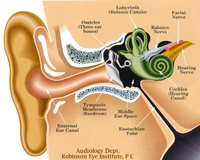The human auditory system is an amazing, complex piece of equipment. Every tiny bone and curve serve a unique purpose. The three major parts of the ear are the outer, middle and the inner. The outer ear is the part that is easily visible. The pinna is like a satellite dish on either side of the head. This dish has a series of cartilaginous curves that are responsible for catching sound and transmitting it down the ear canal to the tympanic membrane (eardrum). To understand the significance of this part of the ear, try cupping your hand behind the ear. There will be an increase in reception. Imagine that your pinna is absent, some sound would pass by without being collected.
Once sound passes down the canal causing the eardrum to vibrate, we reach the middle ear space. Within the middle ear there are three tiny bones (the ossicular or mechanical chain). The first bone is connected to the drum by a tendon. Each bone works in conjunction with its neighbor to carry sound to its destination. The third bone passes in and out of a window, an opening, in the cochlea.
The cochlea is similar to a long balloon filled with fluid, then wound into a coil. There are rows of hair cells present from the outermost part of the cochlea to the innermost. These hair or nerve cells are responsible for different tones. The high pitches are along the first and outer wind of the coil; the low pitches are more to the center. When this area sustains damage, the term nerve damage or nerve loss may be used (this is the most common type of hearing impairment). Sound is transferred from the cochlea to the brain. When any part of this system is blocked or damaged the result will be a loss of hearing and/or speech understanding.
There are problems, which can occur in any sector of the ear. Many of these problems can be medically addressed. A tear in the tympanic membrane can be patched. There are prosthetic bones to replace the original that may not function properly. Fluid or pressure can be relieved via a small tube. However, nerve tissue does not regenerate. When nerve damage (sensori-neural loss) is diagnosed, amplification is often appropriate.
As science and technology evolve, we may see a true bionic ear. As for now, research has brought us hearing aids, equipped with digital processors that are far more advanced than anything we’ve worked with before. Our ability to augment hearing and improve the patient’s ability to function in background noise is always improving.
Information provided by Janice S. White at Hearing Solutions, Inc., (877) 695-4788.


